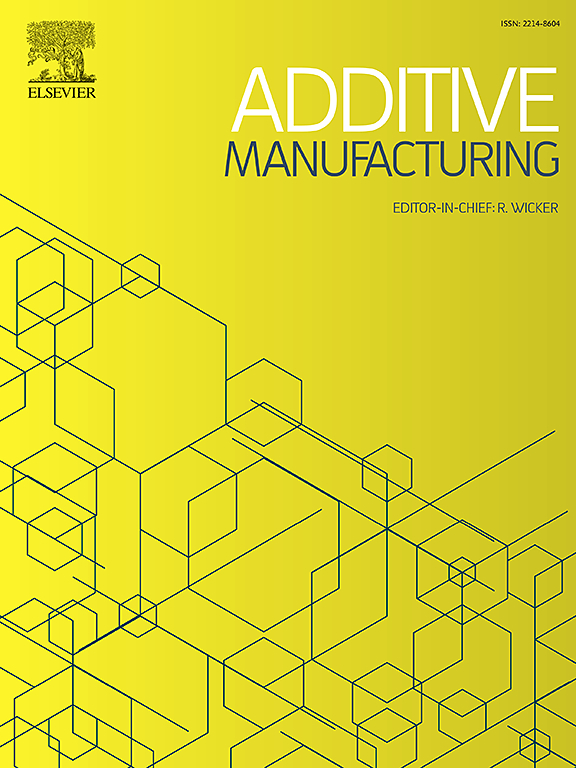揭示激光粉末床熔融过程中缺陷演化的层间动态:原位监测和控制的启示
IF 10.3
1区 工程技术
Q1 ENGINEERING, MANUFACTURING
引用次数: 0
摘要
缺乏熔合(LOF)缺陷会严重影响激光粉末床熔融(LPBF)制造的部件的机械性能。LOF 缺陷的层间演化过程十分复杂,目前尚未得到深入了解。这项研究利用原位监测、原位表面形貌和μ-CT孔隙率表征以及高保真多物理场数值模拟,探索了 LOF 缺陷在各种条件下的时空变化。结果表明,LOF 缺陷可以在超过五个印刷层的条件下表现出典型的自修复特性。具体的自愈合行为取决于缺陷的初始尺寸和 LPBF 工艺条件。LOF 缺陷的演变可以通过使用光强进行原位监测来检测。然而,原位监测可能无法检测到埋藏在愈合层下面的 LOF 缺陷,而这些缺陷可以通过 μ-CT 观察到。对于深度为 150 μm 的缺陷区域,第一至第五印刷层的相对密度从 61.7% 增加到 95.7%。工艺参数的优化表明,采用 45° 扫描角可以显著提高表面平整度,并将内部孔隙修复到最小 36.0 μm。研究结果凸显了原位监测在检测 LOF 缺陷方面的能力,以及受控印刷工艺在加速缺陷修复方面的潜力。这些成果为 LPBF 过程中的原位监测和控制的工业应用提供了宝贵的启示。本文章由计算机程序翻译,如有差异,请以英文原文为准。
Unveiling the layer-wise dynamics of defect evolution in laser powder bed fusion: Insights for in-situ monitoring and control
Lack of fusion (LOF) defects can significantly affect the mechanical properties of components manufactured by laser powder bed fusion (LPBF). The layer-wise evolution of LOF defects is complex and not yet thoroughly understood. This work explores the spatiotemporal variations of LOF defects under various conditions using in-situ monitoring, ex-situ surface topography and μ-CT porosity characterization, and high-fidelity multi-physics numerical simulation. The results show that LOF defects could exhibit typical self-healing characteristics for over five printing layers. The specific self-healing behaviors depend on the initial sizes of the defects and the LPBF process conditions. The evolution of LOF defects can be detected by in-situ monitoring using light intensity. However, the in-situ monitoring may miss detecting LOF defects buried below the healed layers, which were alternatively observed via μ-CT. For the defective area with a depth of 150 μm, the relative density increased from 61.7 % to 95.7 % for the first to the fifth printing layer. The optimization of process parameters demonstrated that the application of a 45° scanning angle could significantly enhance surface flatness and repair internal pores to a minimum of 36.0 μm. The findings highlight the ability of in-situ monitoring in detecting LOF defects and the potential of the controlled printing process to accelerate defect repair. These outcomes offer valuable insights for the industrial applications of in-situ monitoring and control during LPBF.
求助全文
通过发布文献求助,成功后即可免费获取论文全文。
去求助
来源期刊

Additive manufacturing
Materials Science-General Materials Science
CiteScore
19.80
自引率
12.70%
发文量
648
审稿时长
35 days
期刊介绍:
Additive Manufacturing stands as a peer-reviewed journal dedicated to delivering high-quality research papers and reviews in the field of additive manufacturing, serving both academia and industry leaders. The journal's objective is to recognize the innovative essence of additive manufacturing and its diverse applications, providing a comprehensive overview of current developments and future prospects.
The transformative potential of additive manufacturing technologies in product design and manufacturing is poised to disrupt traditional approaches. In response to this paradigm shift, a distinctive and comprehensive publication outlet was essential. Additive Manufacturing fulfills this need, offering a platform for engineers, materials scientists, and practitioners across academia and various industries to document and share innovations in these evolving technologies.
 求助内容:
求助内容: 应助结果提醒方式:
应助结果提醒方式:


